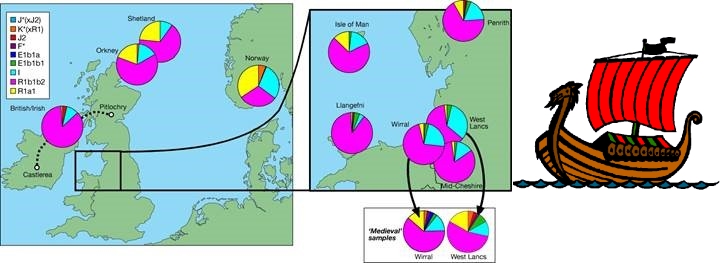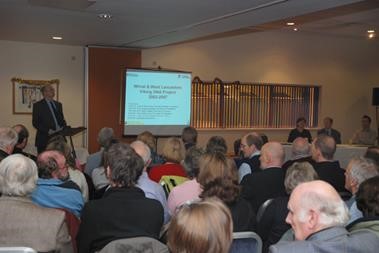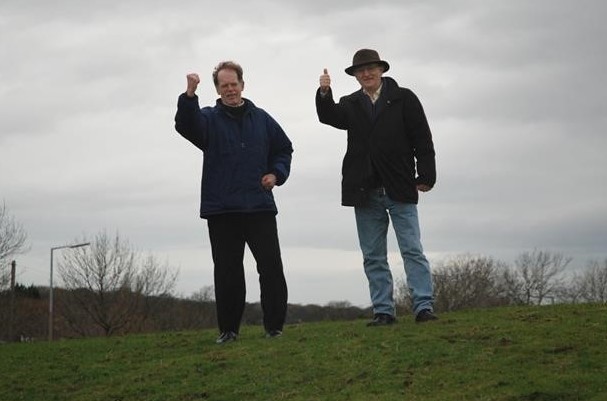Wirral and West Lancashire Viking Page - Genetic Survey

The survey was completed in November 2007 and a paper (click to download) published (2008) in Molecular Biology and Evolution (Oxford University Press)

An associated popular book (click for link) published by CRC PRESS
N.B. We have a further paper based on higher resolution analysis, due out 2020, confirming the earlier results. A link will be posted in due course
THE PROJECT
The Wirral and West Lancashire genealogical survey ran from 2002-2008. Following the interest created in the 2001 BBC Blood of Vikings series in which evidence for descendants of Norwegian Vikings were found in the Scottish Isles, Isle of Man and the North Lakes, a new survey was launched in 2002 looking for evidence for Norse descendants in Wirral and West Lancashire, since the place name and other evidence suggests this area was once populated by Scandinavian settlers.
The survey supported by the U.K. Biotechnology and Biological Sciences Research Council under the prestigious Watson-Crick 50th Anniversary programme was commenced in 2002 by researchers from the Universities of Leicester – the home of Genetic Fingerprinting - and Nottingham and has now been completed. The synopsis for the project was as follows: "If Vikings invaded and settled particular regions of the British Isles, we may be able to see their legacy within the DNA of modern populations of these regions. The male-specific Y chromosome (only about 1% of a man's total DNA) is more likely to have preserved the signal of Viking presence than other parts of our DNA. In this project we extend the BBC's 'Blood of the Vikings' study in the Wirral and SW & West Lancs region, where Viking settlement is known to have been substantial, but where modern population influx has also been great. We plan to analyse the Y chromosomes of men from these regions who also have surnames known to have been present their in mediaeval times, and thus to bypass the recent major population movements in the region that may disturb the relationships between old genes and modern geography".
The results from the project - approximately 50% of the DNA admixture of the old population of Wirral, and also the old population of West Lancashire appears to be Norse-Scandinavian in origin: https://academic.oup.com/mbe/article/25/2/301/1129414 - were presented at a special meeting hosted by the West Lancashire Heritage Association in November 2007 (photographs from the event are shown below). They were published in February 2008 in the leading scientific journal Molecular Biology and Evolution (Oxford University Press). It can be downloaded from here as an open access article. A summary of the findings was also published in British Archaeology in a joint article on the Vikings in the North West with Archaeologist Dr. David Griffiths. A poster summarising the findings is also available. The U.K. Biotechnology and Biological Sciences Research Council award also provided resource for this popular book: VIKING DNA. The Wirral and West Lancashire Project (Steve Harding, Mark Jobling and Turi King, Foreword by Michael Wood). Published December 2010, which is available on both Amazon.co.uk … and Amazon.com, and later in Science & the Vikings: The Hakon Hakonsson Lecture 2016, published by the Largs & District Historical Society, in conjunction with NCMH Outreach.
BACKGROUND
Following the interest created in the 2001 BBC Blood of Vikings series in which evidence for descendants of Norwegian Vikings were found in the Scottish Isles, Isle of Man and the North Lakes, a new survey was launched in 2002 looking for evidence for Norse descendants in Wirral and West Lancashire, since the place name and other evidence suggests this area was once populated by Scandinavian settlers. Despite the large increase in population of Wirral and West Lancashire since the Industrial Revolution, preliminary measurements from a survey done in conjunction with scientists at the University of Nottingham and University College London yielded some promising signs. Encouraged by this it was decided to probe much deeper with a full survey penetrating beyond the Industrial Revolution, by requesting the help of volunteers from old Wirral and West Lancashire families, or volunteers whose surnames are those of places in Wirral or West Lancashire. In this way we can link old genes with modern geography, bypassing the large population influx since Medieval times: the population of Wirral for example has increased by a factor of 60: this is almost 10 times the national average increase.
The survey was performed in 2 parts:
- Wirral (started June 2002).
- West Lancashire (started November 2002)
The survey team was: Professor Steve Harding and Ziff Hansen (University of Nottingham, School of Biosciences), Professor Judith Jesch (School of English), Professor Mark Jobling and Turi King (University of Leicester, Department of Genetics), Patrick Waite (Chairman, West Lancashire Heritage Association, Ormskirk) and Stephen Roberts (Carnforth, Lancashire).
For the survey we focussed on male volunteers from old families in Wirral and West Lancashire: people who can either say their male line goes back before 1700 in Wirral or West Lancashire (or South West Lancashire), or those people who have surnames that were in these areas before 1700: a similar criteria - surnames before 1700 - was applied in a recent survey of the Orkney's. This criterion is critical because of the large influx of people into the area during the Industrial Revolution. For example, the population of Wirral has increased from 5000 in 1545 to 10,000 in 1801 and 350,000 today, a factor of 60: far above the national average (which is only between 6-8 times). The new survey supported by the U.K. Biotechnology and Biological Sciences Research Council under the prestigious Watson-Crick 50th Anniversary programme was commenced in 2002 by researchers from the Universities of Leicester and Nottingham.
SYNOPSIS: OLD SURNAMES, OLD GENES AND MODERN GEOGRAPHY
The synopsis of the project is as follows: "If Vikings invaded and settled particular regions of the British Isles, we may be able to see their legacy within the DNA of modern populations of these regions. The male-specific Y chromosome is more likely to have preserved the signal of Viking presence than other parts of our DNA. In this project we extend the BBC's 'Blood of the Vikings' study in the Wirral and SW & West Lancs region, where Viking settlement is known to have been substantial, but where modern population influx has also been great. We plan to analyse the Y chromosomes of men from these regions who also have surnames known to have been present their in mediaeval times, and thus to bypass the recent major population movements in the region that may disturb the relationships between old genes and modern geography".
GENETIC SURVEY: WIRRAL
The survey of Wirral started in June 2002. We first looked for volunteers from men who have surnames that were present in Wirral in 1545 (from subsidy rolls of all households in Wirral recorded during the reign of Henry VIII) or other medieval records. These are as follows: Adam, Allin, Alleyne, Andrew, Aspinall, Ball, Barber, Barker, Barrell, Barrow, Bailiff, Beck, Bennett, Bergs, Billing, Bird, Blackburne, Boland, Brant, Bratherton, Browne, Brunt, Burscough, Bryde, Burrows, Bushell, Caley, Carr, Carlile, Carlisle, Challoner, Charnock, Chantrell, Coley, Colley, Colton, Coke, Corf, Corfe, Corness, Cotton, Cowper, Cross, Dalby, Dane, Danold, Davey, Davy, Denham, Denson, Dobb, Doe, Done, Duke, Dunn, Edmonds, Edmunds, Ellcock, Fazackerley, Fiddler, Fidler, Foreshaw, Forshaw, Fox, Francis, Gallie, Gardener, Gardiner, Gardner, Garratt, Garrett, Gibson, Gill, Gleave, Glegg, Goodacre, Grace, Gray, Gregory, Grey, Grice, Hale, Hancock, Hand, Harding, Hare, Harper, Harrison, Harvey, Heath, Helsby, Hender, Hesketh, Hey, Heyward, Hide, Hill, Hogg, Hole, Holme, Holmes, Home, Hough, Hulme, Hulmes, Humphrey, Huntington, Hynes, Jennion, Jensen, Jeunds, Johnson, Jump, Kemp, Kirk, Kirkby, Lancelyn, Leck, Ledsham, Leighton, Lennard, Leonard, Ley, Lightfoot, Linacre, Little, Lunt, Macklin, Massie, Massey, Matthew, Mayle, Mayles, Middleton, Milner, Molyneuz, Moss, Moulding, Mutton, Nelson, Newbold, Newton, Otter, Otty, Page, Parr, Pearson, Pemberton, Pendleton, Pennington, Penketh, Penney, Philip, Phylip, Pigot, Pinnington, Plumbe, Poole, Potter, Prenton, Pye, Pyke, Radcliffe, Rathbone, Ravenscroft, Richardson, Rider, Ridley, Rimmer, Robinson, Rogerson, Russell, Rutter, Saddler, Sadler, Sampson, Scaife, Scarff, Scarffe, Scarisbrick, Sclater, Scriven, Sefton, Sharpe, Shephard, Shepherd, Sherlock, Skinner, Smalley, Smythe, Spenser, Stones, Swain, Swaine, Swarbrick, Swindley, Tarleton, Taskar, Tellett, Thomason, Thomasson, Thomson, Threadgill, Threadgold, Tottey, Totty, Tumath, Tyldesley, Wade, Wainwright, Walley, Walton, Warburton, Waring, Warington, Watmough, Watt, Whalley, Wharton, Wilkinson, Williamson, Whitby, Whitehead, Whitelaw, Whitfield, Whitmore, Whittle, Whyte, Williamson, Willoughby, Worral, Woods, Woodward, Wilcock, Wise, Wyse, Young, Yoxon.
Volunteers satisfying these criteria were obtained with the help of the local press, Wirral Grammar School and telephone directories.
GENETIC SURVEY: WEST LANCASHIRE
The survey of West Lancashire started on November 13th (2002) to coincide with the Ormskirk Advertiser Lecture and the 1000th anniversary of the St. Brice's Day Massacre when King Ethelred ordered the slaughter of all Danes in England. You can hear Patrick Waite talk about it in a broadcast on 8th March, a further broadcast with MP Ron Rigby on 5th May, and finally a broadcast on 14th November 2002 by Alison Brown in the YOUTUBE link below (courtesy of BBC Radio Lancashire) which described some of the sampling done in Ormskirk. The survey concentrated on men who have surnames that were present in West Lancashire before 1700. This is of particular interest since West Lancashire has a wealth of Scandinavian place names: there are well over 100 names of status village or above which have clear Viking origins, and if minor names, topographical names are included the list runs into thousands.
We focussed on men with surnames appearing on the two lists below: the List A - based on West Lancashire place names - or List B - based on a list of inhabitants of Ormskirk, Scarisbrick with Hurlton, Bickerstaffe, Burscough with Marton, Westhead with Lathom and Skelmersdale who promised to contribute to the stipend of the priest of the altar of Our Lady at Ormskirk, in the year 1366. Another criterion was that as far as far a volunteer was aware, his father's line (father's father's father etc.) is from West Lancs.
List A:
Aigburth, Ainsdale, Aintree, Altcar, Argarmeols, Beacconsall, Birkdale, Burscough, Crosby, Crossens, Croxteth, Formby, Greetby, Hesketh, Kirkby, Kirkdale, Lathom, Litherland, Lunt, Ormskirk, Ravensmeols, Roby, Scarisbrick, Skelmersdale, Tarleton, Tarlscough, Toxteth and West Derby. Brinscall, Feniscowles, Holgill, Lathom, Leyland, Litherland, Lowgill, Lunt, Norbreck, Scales, Scarisbrick, Swarbrick, Thrushgill, Warbreck
List B:
Abbey, Ainscough, Alexson?, Ashurst, Askins, Ashken, Astin, Aspinall, Aspinwall, Astmole, Aughton, Backhouse, Badger, Balshaw, Barker, Barret(t), Barrow, Barton, Baxter, Becokson, Benson?, Bere, Bear, Bickerstaff, Bird, Blanchard, Blower, Blythe, Bligh, Bold, Bold(son), Bower, Brabourn, Bre(re)ton, Bretherton, Brotherton, Broadfield, Broadhead, Bromborough, Bronley (and variants), Brookfield, Brown, Burscough, Cadick, Caddick, Carpenter, Carr, Carter, Chalonner, Challener, Challender, Challenor, Charles, Checker, Childsfather, Clerk, Cole, Coly, Cooper, Coppell, Copphull, Cowdrey, Cowdray, Cowdroy, Cross, Davy, Deepdale, Dewacre, Dickinson, Dobson, Dodgeson, Dodgson, Drake, Eggacre, Ellerbeck, Ellin, Elliott, Fleming, Fletcher, Foster(son), Fox, Fresh, Fuller, Gilson, Goodacre, Greasby, Greaves, Green, Grey, Gray, Hall, Hallknave, Halshaw, Hamilton, Hancock, Hartblood, Haskin(s), Haskings, Heath, Helmes, Henry(son), Henson, Holbrook, Holland, Holmes, Horsecarr, Hubert, Hunt, Hurlton, Huyton, Irby, Jackson, Jones, Johnson/Jones(son), Kay, Kemp, Kendal, King, Kir(k)by, Lagard, Lauder, Leadbetter, Leigh/Lee/Lea, Leyland, Lone, Long, Longback, Longton, Maddoc(k), Marhall, Marriott, Marton, Maulby, Mell, Melling, Mercer, Messenger, Milner, Moorcroft, Moorhills, More/Moore, Moss, Mossbury, Mossock, Nicholson, Nickson. Oldham, Ollif, Olton/Oulton, Orell, Otty, Outhead, Overton, Owenbreck, Overbeck, Owenson, Page, Parker, Parlement, Parr, Pawson, Peacock?, Penidale/Pennydale, Penwortham, Petty, Pickhare, Pigeon, Platt, Porter, Prescott, Priestman, Pye/Pie, Rainford, Rainhill, Reader?, Rideout, Riding, Roberts/Robertson, Robinson, Salter, Scholes/Scales, Serjeant/Sargeant etc., Shakalady, Shaw, Shuster, Smallshaw, Smithson, Sowerby, Spence, Spencer, Spicer, Spink(s), Spurrier, Staynes, Steel, Stotfoldshaw, Stranger, Such/Sutch/Souch/Zouch/Chuck/Chucks, Sutton, Swan, Tarbert, Taylor, Tew, Thomas(man), Thomas/Thompson etc., Thomasson, Todd, Topping, Turner, Tyldesleigh, Vale, Walker, Wall, Walsh, Walterson, Waring, Warner, Webster, Westhead, Wild, Wildbold/Wildblood, Williams(son), Wilson, Winmarleigh, Wo(o)lfall, Woldes, Wolfall, Woodloft., Woods, Wyresdale, Yate(s).
The 1366 document, at the Lancashire Record Office, Preston, was reproduced in the Ormskirk & District Family Historian, Spring 1991 (ISBN 0 947915 28 1). The transcription to modern day names was done by Stephen Roberts. Volunteers satisfying these criteria were obtained by the West Lancashire Heritage Association in conjunction with the Ormskirk Advertiser and Liverpool Daily Post
THE FINAL LIST OF VOLUNTEERS
The Wirral data included volunteers bearing the following surnames: Barker, Beck, Bennett, Billing, Bird, Bryde, Bushell, Colley, Corfe, Edmunds, Forshaw, Lancelyn-Green, Gill, Harding, Hesketh, Holmes, Hough, Joynson, Kemp, Kirby, Kirk, Lunt, Oxton, Raby, Rathbone, Richardson, Rimmer, Robinson, Scarisbrick, Sherlock, Skinner, Sampson, Tasker, Tillett, Tottey/Totty, Upton, Young.
The West Lancashire data included volunteers bearing the following surnames: Alker, Balshaw, Bilsborrow, Brown, Carr, Charnock, Coly, Cook, Cooper, Corfe, Crombleholme, Fletcher, Gill, Gray, Hesketh, Holland, Holmes, Hulme, Johnson, Leyland, Lunt, Melling, Molyneux, Otty, Pendleton, Penketh, Pennington, Prescott, Rigby, Rimmer, Risley, Roby, Scarisbrick, Sephton, Serjeant, Swarbrick, Thomason, Walsh/Welch, Webster, Westhead.
To avoid bias of the data, duplicate surnames were excluded from the analyses.
OTHER PUBLICATIONS
Besides the recent publications referred to above the background to this survey published at the start of the project in 2002 is described in the book VIKING MERSEY: Scandinavian Wirral, West Lancashire and Chester, and provides an excellent companion volume to Viking DNA, as well ast the 2016 book Science and the Vikings, based on the 2016 Hakon Hakonsson Lecture given at the Largs Historical Society - you can view a recording on this link.
PHOTOGRAPH FROM THE 27TH NOV 2007 EVENT AT KNOWSLEY:

28th NOVEMBER 2007: STEVE AND TORGRIM BREAK THE NEWS TO THE WIRRAL THING
Prof.Steve Harding & Prof. Torgrim Titlestad (University of Stavanger) on the Lawspeakers mound at Cross Hill, Thingwall

RELATED LINKS

(8 BBC Broadcasts from local Radio & TV)
Return to Wirral & West Lancashire Viking Page